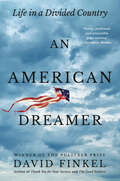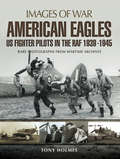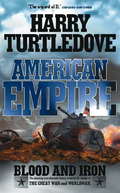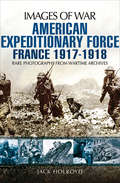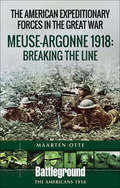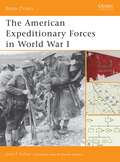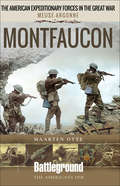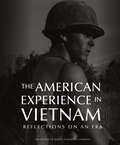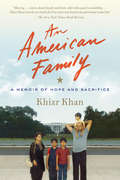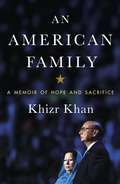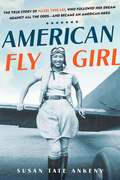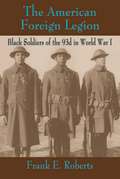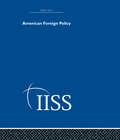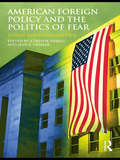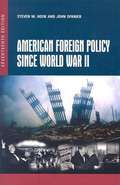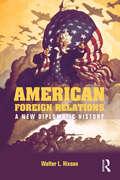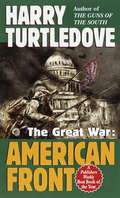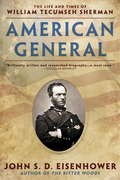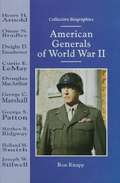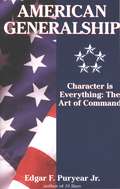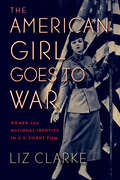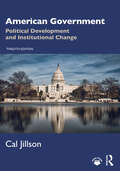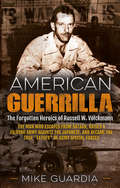- Table View
- List View
An American Dreamer: Life in a Divided Country
by David FinkelA man navigates the deep divisions in America today and discovers that sometimes change can start by finding common ground with your neighbors in this immersive account by the Pulitzer Prize–winning author of Thank You for Your Service and The Good Soldiers.&“Finkel&’s account is poetic, profound, and irresistibly page-turning.&”—Geraldine Brooks, author of HorseAs this powerful book begins, Brent Cummings finds himself coping with the feeling that the country he loves is fracturing in front of his eyes. An Iraq war veteran, raised to believe in a vision of America that values fairness, honesty, and respect for others, Cummings is increasingly surprised by the behavior and beliefs of others, and engulfed by the fear, anger, and confusion that is sweeping through his beloved country as he tries to hold on to his values and his hope for America&’s future.David Finkel, known for his unique, in-depth reporting, spent fourteen years deep inside Brent Cummings&’s world to create this intimate and vivid portrait of a man&’s life, his work, family, community, his thoughts, and his quest for connection, as America becomes ever more divided. Cummings was one of the unforgettable figures in Finkel&’s The Good Soldiers, a book about which The New York Times stated, &“Finkel has made art out of a defining moment in history. You will be able to take this book down from the shelf years from now, and say: This is what happened. This is what it felt like.&”An American Dreamer illuminates, with the deepest empathy, the feelings and lives of many people in America today, and it is a brilliant chronicle of one person&’s everyday experiences of frustration, confusion, and hope.
American Eagles: Rare Photographs From Wartime Archives (Images of War)
by Tony HolmesAmerican Eagles provides a photographic snapshot of the lives of the American fighter pilots who volunteered their services during World War II, as well as the Spitfires and Hurricanes they flew. Keen to help Britain stem the spread of Fascism, or perhaps seeking adventure in a foreign land, a number of American citizens defied the wishes of their government by crossing the border into Canada and subsequently sailing to Britain to join the Royal Air Force. Some were prewar civilian pilots, others were rich playboys and a few were already serving in the RAF when war was declared. Men such as Don Blakeslee, Billy Fiske, 'Gus' Daymond and Jim Dunn, as well as many other notable pilots are featured in this volume, in photographs that have been carefully sourced from official and private archives across the globe. Each image has a detailed caption, chronicling the wartime exploits of the elite 'band of brothers' known as the American Eagles.
American Empire: Blood and Iron
by Harry TurtledoveThe first volume of the American Empire trilogy from Harry Turtledove, "The Wizard of If".As Turtledove's brilliant series The Great War came to its end, the United States of America, in alliance with Germany, had defeated Great Britain, France and the Confederate States of America in a bloody conflict known as the First World War.Now as the 1920s begin, though, the seeds of a new conflict have already been sown. The United States, led by Theodore Roosevelt, swings wildly towards socialism. In Canada - now a US colony - nationalist terrorists strike against the new American oppressors. But it is in the Confederacy, trapped in a ruinous economic depression, where fascism begins to spread, and the fires are fanned by a charismatic leader who may again plunge the world into war.
American Expeditionary Force: France, 1917–1918 (Images of War)
by Jack HolroydWhen the United States entered the war in April 1917 the belligerents were approaching exhaustion. It had been hoped by the Generals in both Britain and France that untold numbers of fresh troops would be assimilated into their respective commands. However, this idea was firmly resisted, America would field its own army alongside the Allies it would have its own section on the front line. Those with concerns that the untried divisions under General Pershing would fair badly against the seasoned German military machine were soon reassured as impressive victories were won by the newcomers. The book is split into eight chapters which deal with different pivotal moments during the First World War from the American perspective, from the reasons behind the American involvement in the war and initial training to the major battles at Cantigny, Chateau Thierry and St. Mihiel. This story is told in pictures gleaned from the official archives which were first published in 1920 and now presented for reexamination and public awareness in the Images of War series.
American Expeditionary Force: France, 1917–1918 (Images of War)
by Jack HolroydWhen the United States entered the war in April 1917 the belligerents were approaching exhaustion. It had been hoped by the Generals in both Britain and France that untold numbers of fresh troops would be assimilated into their respective commands. However, this idea was firmly resisted, America would field its own army alongside the Allies it would have its own section on the front line. Those with concerns that the untried divisions under General Pershing would fair badly against the seasoned German military machine were soon reassured as impressive victories were won by the newcomers. The book is split into eight chapters which deal with different pivotal moments during the First World War from the American perspective, from the reasons behind the American involvement in the war and initial training to the major battles at Cantigny, Chateau Thierry and St. Mihiel. This story is told in pictures gleaned from the official archives which were first published in 1920 and now presented for reexamination and public awareness in the Images of War series.
The American Expeditionary Forces in the Great War: Meuse Argonne 1918: Breaking the Line (Battleground The Americans 1918)
by Maarten Otte&“An invaluable and extraordinary&” account of the bloodiest battle in American military history (Midwest Book Review). Although the Meuse-Argonne Offensive, which began in late September 1918 and continued through to the Armistice, was not the first major action fought by the AEF, it was the greatest in which it engaged in the Great War. The Argonne was an area that had been heavily fought over, particularly in the early part of the war; its eastern part, towards the Meuse, then became enveloped in the first great attritional battle of the war, Verdun. Maarten Otte gives a background narrative to events before the opening of the Offensive and its development. Taking each of the US corps in turn, he then provides tours that will help the visitor to understand the fighting and the problems that were faced. This opening book on the Meuse-Argonne takes the reader, more or less, to the date when General Pershing handed over command of the US First Army to Major General Liggard in mid-October, a change in command that marked a significant improvement in the American performance as they pushed the Germans ever backwards. The Great War battlefield of the Argonne is marked by numerous physical remains of the war, some fine (some might argue overly grandiose) monuments and by the stunning American cemetery at Romagne, the second largest in the world administered by the American Battle Monuments Commission. There is much to see in a battlefield that has been largely neglected in the decades since the Second World War.
The American Expeditionary Forces in World War I
by John VotawUpon the entry of the United States into World War I, the American Expeditionary Forces (AEF) were created by the War Department on short notice from existing units, filled up with men from the training camps and deployed with only their personal weapons and equipment. The US Army was not prepared for combat in France, and the remarkable achievement of the AEF's commanding officer, John J Pershing, was the creation of an American field army, built and nurtured from the bottom up. This book details the organizational structure, training and doctrine of the AEF and illustrates how it came to make a significant contribution to Allied victory in World War I.
American Expeditionary Forces in WWI: Montfaucon (Battleground Books: Wwi Ser.)
by Maarten OtteAny visitor to the site of the bloodiest battle in the history of the United States will be drawn to Montfaucon, for it is here that General Pershing, the Commander in Chief, determined that the major memorial to the American Expeditionary Forces would be sited. The impressive classical column, erected on the summit of Montfaucon Hill, can be seen from many parts of the battlefield of the Meuse-Argonne 1918.The village of Montfaucon, perched on and around one of the most notable heights in the Argonne area, was a first day objective for the First American Army in its massive offensive that was launched on 26 September 1918 and which rumbled on until the Armistice.Montfaucon had been the scene of bitter fighting between the French and the Germans in the early stages of the war, finally staying securely in German hands. The attack started well, with the great numbers of Doughboys easily moving through the first line of the German defense system; and, indeed, good progress was made all along the front, even if final objectives were not attained that would have brought the Americans up to the Hindenburg Line defenses. The most notable setback was the failure to capture Montfaucon, an objective given to the 79th Division. Why the task of capturing this key part of the German line to a 'green' division, composed of draftees and which had only had six weeks or so of training time in France, instead of the prescribed three months, has never been adequately explained.What has proved to be controversial ever since is why the 4th Division, a regular formation that had already been engaged in battle on the Western Front and which gained its objectives on the first day, did not seek to assist the 79th when it was clear that it was facing significant difficulties in overcoming the Montfaucon defenses. The outcome was that the village and hill did not fall on the first day. How significant this setback was to the success and the duration of the offensive has also been the subject of considerable discussion.Montfaucon was an important observation point for much of the war, providing distant views over considerable amounts of ground and thus invaluable for the German artillery. How much its loss mattered to the Germans when fighting a defensive battle, with the defense lines south of it already lost, is more open to debate, given the vantage points that the Germans continued to enjoy from high ground to the north-west and east.Maarten Otte sets the importance of Montfaucon and the ultimately successful effort to capture it within a succinct narrative. In the tours section he takes the visitor on a number of routes so that they can see for themselves the problems on the ground that faced the 79th Division and puts Montfaucon in the context of the wider battle. He also provides a detailed tour of the village and hill itself, including the magnificent memorial and the preserved defenses and ruins which surround it.
The American Experience in Vietnam: Reflections on an Era
by The Editors of Boston Publishing CompanyThe landmark, Pulitzer Prize–nominated, bestselling illustrated history, updated for the fiftieth anniversary of the Vietnam War.When it was originally published, the twenty-five-volume Vietnam Experience offered the definitive historical perspectives of the Vietnam War from some of the best rising authors on the conflict. This new and reimagined edition updates the war on the fifty years that have passed since the war’s initiation. The official successor to the Pulitzer Prize–nominated set, The American Experience in Vietnam combines the best serious historical writing about the Vietnam War with new, never-before-published photos and perspectives. New content includes social, cultural, and military analysis; a view of post-1980s Vietnam; and contextualizing discussion of US involvement in the Persian Gulf, Iraq, and Afghanistan. Even if you own the original, The American Experience in Vietnam is a necessary addition for any modern Vietnam War enthusiast.Praise for The American Experience in Vietnam“The heart of the book is a well-written, objectively presented history of the war that includes a lot of military history.” —Vietnam Veterans of America
An American Family: A Memoir of Hope and Sacrifice
by Khizr KhanIn fewer than three hundred words, Khizr Khan electrified viewers around the world when he took the stage at the 2016 Democratic National Convention. And when he offered to lend Donald Trump his own much-read and dog-eared pocket Constitution, his gesture perfectly encapsulated the feelings of millions. But who was that man, standing beside his wife, extolling the promises and virtues of the U.S. Constitution? <p><p> In this urgent and timeless immigrant story, we learn that Khizr Khan has been many things. He was the oldest of ten children born to farmers in Pakistan, and a curious and thoughtful boy who listened rapt as his grandfather recited Rumi beneath the moonlight. He was a university student who read the Declaration of Independence and was awestruck by what might be possible in life. He was a hopeful suitor, awkwardly but earnestly trying to win the heart of a woman far out of his league. He was a brilliant and diligent young family man who worked two jobs to save enough money to put himself through Harvard Law School. He was a loving father who, having instilled in his children the ideals that brought him and his wife to America—the sense of shared dignity and mutual responsibility—tragically lost his son, an Army captain killed while protecting his base camp in Iraq. He was and is a patriot, and a fierce advocate for the rights, dignities, and values enshrined in the American system. <p> An American Family shows us who Khizr Khan and millions of other American immigrants are, and why—especially in these tumultuous times—we must not be afraid to step forward for what we believe in when it matters most.
An American Family: A Memoir Of Hope And Sacrifice
by Khizr Khan'Khan's aspirational memoir reminds us all why Americans should welcome newcomers from all lands' Kirkus ReviewsIn fewer than three hundred words, Khizr Khan electrified viewers around the world when he took the stage at the 2016 Democratic National Convention. And when he offered to lend Donald Trump his own much-read and dog-eared pocket Constitution, his gesture perfectly encapsulated the feelings of millions. But who was that man, standing beside his wife, extolling the promises and virtues of the U.S. Constitution?In this urgent and timeless immigrant story, we learn that Khizr Khan has been many things. He was the oldest of ten children born to farmers in Pakistan, and a curious and thoughtful boy who listened rapt as his grandfather recited Rumi beneath the moonlight. He was a university student who read the Declaration of Independence and was awestruck by what might be possible in life. He was a hopeful suitor, trying to win the heart of a woman far out of his league. He was a brilliant and diligent young family man who worked two jobs to save enough money to put himself through Harvard Law School. He was a loving father who tragically lost his son, an Army captain killed while protecting his base camp in Iraq. He was and is a patriot, and a fierce advocate for the rights, dignities and values enshrined in the American system.An American Family shows us who Khizr Khan and millions of other American immigrants are, and why-especially in these tumultuous times-we must not be afraid to step forward for what we believe in when it matters most.
American Flygirl
by Susan Tate AnkenyOne of WWII&’s most uniquely hidden figures, Hazel Ying Lee was the first Asian American woman to earn a pilot&’s license, join the WASPs, and fly for the United States military amid widespread anti-Asian sentiment and policies. Her singular story of patriotism, barrier breaking, and fearless sacrifice is told for the first time in full for readers of The Women with Silver Wings by Katherine Sharp Landdeck, A Woman of No Importance by Sonia Purnell, The Last Boat Out of Shanghai by Helen Zia, Facing the Mountain by Daniel James Brown and all Asian American, women&’s and WWII history books. In 1931, Hazel Ying Lee, a nineteen-year-old American daughter of Chinese immigrants, sat in on a friend&’s flight lesson. It changed her life. In less than a year, a girl with a wicked sense of humor, a newfound love of flying, and a tough can-do attitude earned her pilot&’s license and headed for China to help against invading Japanese forces. In time, Hazel would become the first Asian American to fly with the Women Airforce Service Pilots. As thrilling as it may have been, it wasn&’t easy. In America, Hazel felt the oppression and discrimination of the Chinese Exclusion Act. In China&’s field of male-dominated aviation she was dismissed for being a woman, and for being an American. But in service to her country, Hazel refused to be limited by gender, race, and impossible dreams. Frustrated but undeterred she forged ahead, married Clifford Louie, a devoted and unconventional husband who cheered his wife on, and gave her all for the cause achieving more in her short remarkable life than even she imagined possible. American Flygirl is the untold account of a spirited fighter and an indomitable hidden figure in American history. She broke every common belief about women. She challenged every social restriction to endure and to succeed. And against seemingly insurmountable obstacles, Hazel Ying Lee reached for the skies and made her mark as a universal and unsung hero whose time has come.
The American Foreign Legion
by Frank E. RobertsStill segregated in World War I, the U.S. Army was reluctant to use its 93d division of black soldiers in combat and instead assigned the division's three National Guard and one draftee regiments to the French Army. The battlefield successes of these African Americans under the French at the height of the German offensives in 1918 turned white expectations of failure upside down. Their bravery and heroism gained the respect of French and German alike and called into question the U.S. Army's policy of racially segregating its divisions. The full story of their accomplishments is told here for the first time through the eyes of the enlisted men and their white and black officers.The book highlights the actions of individuals as well as the various units of the 93d in compelling combat scenes. We join Company C of the 370th Infantry under heavy fire as they capture artillery pieces, machine guns, and even a portion of a railroad track to win a unit citation and the Croix de Guerre. We learn about the extraordinary actions of Corporal Freddie Stowers, the only African American in the war to be nominated for-and seventy years later awarded-the Medal of Honor, and others who earned the Distinguished Service Cross and French awards for gallantry in combat. Their story of overcoming the odds at a time when most believed blacks performed poorly in combat is told by Frank Roberts, who has been researching the subject for years. While his book acknowledges the many problems encountered by the 93d, the focus is on the many triumphs of these tenacious soldiers as they fought the enemy and the prejudices of their fellow Americans. This book is published in cooperation with the Association of the United States Army.
American Foreign Policy (Adelphi Papers Reissue Hardback)
by variousComplete set Since 1961 the Adelphi Papers have provided some of the most informed accounts of international and strategic relations. Produced by the world renowned International Institute of Strategic Studies, each paper provides a short account of a subject of topical interest by a leading military figure, policy maker or academic. The project reprints the first forty years of papers, arranged into thematic sets. The collection as a whole provides a rich and insightful account of international affairs during a period which spans the second half of the Cold War, the fall of the communist bloc and the emergence of a new regime with the United States as the sole superpower. There is a wealth of global coverage: Four volumes on east and southeast Asia as well as individual volumes on China, Japan and Korea Particular attention is given to the Middle East, with volumes addressing internal sources of instability; geo-politics and the role of the superpowers; the Israel-Palestine conflict; and the Iran-Iraq War and the first Gulf War. There is also a volume on oil and insecurity There are also two volumes on Africa, the site of most of the world’s wars during the period. The IISS has obviously made a particular contribution to the understanding of military strategy, and this is reflected with material on topics such as urban and guerrilla warfare, nuclear deterrence and the role of information in modern warfare. Volumes on military strategy are complemented by approaches from other disciplines, such as defence economics. Key selling points: Early papers were only distributed by the IISS and will have achieved limited penetration of the academic market A host of major authors on a range of different subjects (eg Gerald Segal on China, Michael Leifer on Southeast Asia, Sir Lawrence Freidman on the revolution in military affairs, Raymond Vernon on multinationals and defence economics) Individual volumes will have a strong appeal to different markets (eg the volume on defence economics for economists, various volumes for Asian Studies etc)
American Foreign Policy and The Politics of Fear: Threat Inflation since 9/11 (Routledge Global Security Studies)
by A. Trevor Thrall Jane K. CramerThis edited volume addresses the issue of threat inflation in American foreign policy and domestic politics. The Bush administration's aggressive campaign to build public support for an invasion of Iraq reheated fears about the president's ability to manipulate the public, and many charged the administration with 'threat inflation', duping the news media and misleading the public into supporting the war under false pretences. Presenting the latest research, these essays seek to answer the question of why threat inflation occurs and when it will be successful. Simply defined, it is the effort by elites to create concern for a threat that goes beyond the scope and urgency that disinterested analysis would justify. More broadly, the process concerns how elites view threats, the political uses of threat inflation, the politics of threat framing among competing elites, and how the public interprets and perceives threats via the news media. The war with Iraq gets special attention in this volume, along with the 'War on Terror'. Although many believe that the Bush administration successfully inflated the Iraq threat, there is not a neat consensus about why this was successful. Through both theoretical contributions and case studies, this book showcases the four major explanations of threat inflation -- realism, domestic politics, psychology, and constructivism -- and makes them confront one another directly. The result is a richer appreciation of this important dynamic in US politics and foreign policy, present and future. This book will be of much interests to students of US foreign and national security policy, international security, strategic studies and IR in general. Trevor Thrall is Assistant Professor of Political Science and directs the Master of Public Policy program at the University of Michigan - Dearborn. Jane Kellett Cramer is an Assistant Professor of Political Science at the University of Oregon.
American Foreign Policy Since World War II (17th Edition)
by Steven W. Hook John SpanierThe United States remains engaged in an open-ended "war on terrorism" with no foreseeable endpoint.
American Foreign Relations: A New Diplomatic History
by Walter L. HixsonAmerican Foreign Relations: A New Diplomatic History is a compelling narrative history of American foreign policy from the early settlement of North America to the present. In addition to economic and strategic motives, Walter L. Hixson integrates key cultural factors--including race, gender, and religion--into the story of American foreign policy. He demonstrates how these factors played a vital role in shaping the actions of the United States in world affairs. Beginning with the history of warfare and diplomacy between indigenous peoples and Europeans before the establishment of the United States, this book shows the formative influence of settler colonialism on the country's later foreign policy and the growth of American empire. Clearly written and comprehensive, the book features: Extensive illustrations, with over 100 images and maps Primary documents in each chapter, showcasing the perspectives of historical actors "Interpreting the Past" features that explore how historians' understanding of events has changed over time Selected bibliographies of key resources for further research in each chapter In one concise volume, American Foreign Relations covers the full sweep of American foreign policy from the colonial period to the present day. It is an essential introduction for anyone seeking to understand the history of America's role in the world.
American Front: American Front (Southern Victory: The Great War #1)
by Harry TurtledoveWhen the Great War engulfed Europe in 1914, the United States and the Confederate States of America, bitter enemies for five decades, entered the fray on opposite sides: the United States aligned with the newly strong Germany, while the Confederacy joined forces with their longtime allies, Britain and France. But it soon became clear to both sides that this fight would be different--that war itself would never be the same again. For this was to be a protracted, global conflict waged with new and chillingly efficient innovations--the machine gun, the airplane, poison gas, and trench warfare.Across the Americas, the fighting raged like wildfire on multiple and far-flung fronts. As President Theodore Roosevelt rallied the diverse ethnic groups of the northern states--Irish and Italians, Mormons and Jews--Confederate President Woodrow Wilson struggled to hold together a Confederacy still beset by ignorance, prejudice, and class divisions. And as the war thundered on, southern blacks, oppressed for generations, found themselves fatefully drawn into a climactic confrontation . . .From the Paperback edition.
American General
by John S.D. EisenhowerFrom respected historian John S. D. Eisenhower comes a surprising portrait of William Tecumseh Sherman, the Civil War general whose path of destruction cut the Confederacy in two, broke the will of the Southern population, and earned him a place in history as "the first modern general." Yet behind his reputation as a fierce warrior was a sympathetic man of complex character. A century and a half after the Civil War, Sherman remains one of its most controversial figures--the soldier who brought the fight not only to the Confederate Army, but to Confederate civilians as well. Yet Eisenhower, a West Point graduate and a retired brigadier general (Army Reserves), finds in Sherman a man of startling contrasts, not at all defined by the implications of "total war." His scruffy, disheveled appearance belied an unconventional and unyielding intellect. Intensely loyal to superior officers, especially Ulysses S. Grant, he was also a stalwart individualist. Confident enough to make demands face-to-face with President Lincoln, he sympathetically listened to the problems of newly freed slaves on his famed march from Atlanta to Savannah. Dubbed "no soldier" during his years at West Point, Sherman later rose to the rank of General of the Army, and though deeply committed to the Union cause, he held the people of the South in great affection.In this remarkable reassessment of Sherman's life and career, Eisenhower takes readers from Sherman's Ohio origins and his fledgling first stint in the Army, to his years as a businessman in California and his hurried return to uniform at the outbreak of the war. From Bull Run through Sherman's epic March to the Sea, Eisenhower offers up a fascinating narrative of a military genius whose influence helped preserve the Union--and forever changed war.
American Generals of World War II (Collective Biographies)
by Ron KnappForty to fifty million people died in World War II as the allied armies of the United States, Britain and the USSR battled the axis forces of Nazi Germany, Italy and Japan. The American generals from the Army, the Army Air Forces, and the Marines who played indispensable roles in winning that war include: Henry Arnold, Omar Bradley, Dwight Eisenhower, Curtis LeMay, Douglas MacArthur, George Marshall, George Patton, Matthew Ridgeway, Holland Smith, and Joseph Stilwell. Featured are accounts of their military training and accomplishments as well as many quotes and anecdotes from the battlefield.
American Generalship: Character Is Everything: The Art of Command
by Edgar PuryearAmerica's top military leaders are scrutinized as Puryear ponders what prepared our generals for the terrible responsibilities they bore during World War II, Korea, Vietnam, the Gulf War and on to today.
The American Girl Goes to War: Women and National Identity in U.S. Silent Film (War Culture)
by Liz ClarkeDuring the 1910s, films about war often featured a female protagonist. The films portrayed women as spies, cross-dressing soldiers, and athletic defenders of their homes—roles typically reserved for men and that contradicted gendered-expectations of home-front women waiting for their husbands, sons, and brothers to return from battle. The representation of American martial spirit—particularly in the form of heroines—has a rich history in film in the years just prior to the American entry into World War I. The American Girl Goes to War demonstrates the predominance of heroic female characters in in early narrative films about war from 1908 to 1919. American Girls were filled with the military spirit of their forefathers and became one of the major ways that American women’s changing political involvement, independence, and active natures were contained by and subsumed into pre-existing American ideologies.
American Government: Political Development and Institutional Change
by Cal JillsonHow politics in America works today, how it got that way, and how it’s likely to change through reform—these are the themes that pervade every chapter of Cal Jillson’s highly lauded American Government: Political Development and Institutional Change. Even in the midst of current challenges, America’s past is present in all aspects of the contemporary political system. Jillson uses political development and the dynamics of change as a thematic tool to help students understand how politics works now—and how institutions, participation, and policies have evolved over time to produce the contemporary political environment. In addition, Jillson helps students think critically about how American democracy might evolve further, focusing in every chapter on reform and further change. New to the 12th Edition: Assesses the characteristics and results of the Trump administration and the policy and tonal changes of the early Biden adminstration. Describes numerous ways in which the American political system has been affected by the Covid-19 pandemic Assesses the implications of the January 6, 2021 attack on the Capitol and what it implies for our political culture and partisan politics. Assesses the implication of "fake news" and "the move to mobile" for our politics. Explores the evidence for increasing polarization in public opinion, voting behavior, and the work of Congress and the courts.. Details the impact that the Russian invasion of Ukraine had on President Biden’s attempt to rebuild U.S. national security alliances.
American Grand Strategy in the Mediterranean during World War II
by Andrew BuchananThis book offers a thorough reinterpretation of U. S. engagement with the Mediterranean during World War II. Andrew Buchanan argues that the United States was far from being a reluctant participant in a peripheral theater, and that Washington had a major grand-strategic interest in the region. By the end of the war the Mediterranean was essentially an American lake, and the United States had substantial political and economic interests extending from North Africa, via Italy and the Balkans, to the Middle East. This book examines the military, diplomatic, and economic processes by which this hegemonic position was assembled and consolidated. It discusses the changing character of the Anglo-American alliance, the establishment of post-war spheres of influence, the nature of presidential leadership, and the common interest of all the leaders of the Grand Alliance in blocking the development of potentially revolutionary movements emerging from the chaos of war, occupation, and economic breakdown.
American Guerrilla: The Forgotten Heroics of Russell W. Volckmann—the Man Who Escaped from Bataan, Raised a Filipino Army against the Japanese, and Became the True “Father” of Army Special Forces
by Mike GuardiaA main selection of the Military Book Club and a selection of the History Book Club With his parting words, "I shall return," General Douglas MacArthur sealed the fate of the last American forces on Bataan. Yet one young Army Captain named Russell Volckmann refused to surrender. He disappeared into the jungles of north Luzon where he raised a Filipino army of more than 22,000 men. For the next three years he led a guerrilla war against the Japanese, killing more than 50,000 enemy soldiers. At the same time he established radio contact with MacArthur's headquarters in Australia and directed Allied forces to key enemy positions. When General Yamashita finally surrendered, he made his initial overtures not to MacArthur, but to Volckmann. This book establishes how Volckmann's leadership was critical to the outcome of the war in the Philippines. His ability to synthesize the realities and potential of guerrilla warfare led to a campaign that rendered Yamashita's forces incapable of repelling the Allied invasion. Had it not been for Volckmann, the Americans would have gone in "blind" during their counter-invasion, reducing their efforts to a trial-and-error campaign that would undoubtedly have cost more lives, materiel, and potentially stalled the pace of the entire Pacific War. Second, this book establishes Volckmann as the progenitor of modern counterinsurgency doctrine and the true "Father" of Army Special Forces--a title that history has erroneously awarded to Colonel Aaron Bank of the European Theater of Operations. In 1950, Volckmann wrote two army field manuals: Operations Against Guerrilla Forces and Organization and Conduct of Guerrilla Warfare, though today few realize he was their author. Together, they became the US Army's first handbooks outlining the precepts for both special warfare and counter-guerrilla operations. Taking his argument directly to the army chief of staff, Volckmann outlined the concept for Army Special Forces. At a time when US military doctrine was conventional in outlook, he marketed the ideas of guerrilla warfare as a critical force multiplier for any future conflict, ultimately securing the establishment of the Army's first special operations unit--the 10th Special Forces Group. Volckmann himself remains a shadowy figure in modern military history, his name absent from every major biography on MacArthur, and in much of the Army Special Forces literature. Yet as modest, even secretive, as Volckmann was during his career, it is difficult to imagine a man whose heroic initiative had more impact on World War II. This long overdue book not only chronicles the dramatic military exploits of Russell Volckmann, but analyzes how his leadership paved the way for modern special warfare doctrine. Mike Guardia, currently an officer in the US 1st Armored Division is also author of Shadow Commander, about the career of Donald Blackburn, and an upcoming biography of Hal Moore.
